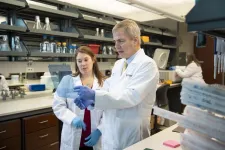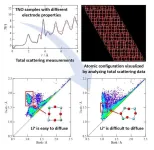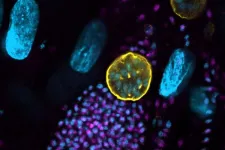(Press-News.org) University of Cincinnati Cancer Center experts will present abstracts at the 66th American Society of Hematology (ASH) Annual Meeting and Exposition Dec. 7-10 in San Diego.
Trial finds AML drug is safe in healthy volunteers
A randomized Phase 1 trial in healthy volunteers found a new drug targeting treatment-resistant acute myeloid leukemia (AML) is safe and attains drug levels that would predict response in this disease.
Up to 30% of patients with AML have a specific mutation called FLT-3, and a standard FLT-3 treatment called gilteritinib was approved by the Food and Drug Administration in 2018. But as the cancer has evolved, patients have developed both intolerance and resistance to gilteritinib.
Members of the Cancer Center’s Leukemia and Drug Development Lab (LDDL) — including John Byrd, MD; Erin Hertlein, PhD; and Ola Elgamal, PhD — partnered with pharmaceutical company Eilean Therapeutics to identify a new drug from initial chemical matter in the laboratory to trials in the clinic to treat the treatment-resistant AML with FLT-3 mutation.
After testing more than 60 compounds developed together with the company, researchers found one of them, lomonitinib, appears to be the most effective in preclinical testing of novel animal models created by the LDDL.
Extending from the preclinical work, Eilean, working with members of the LDDL, sought to de-risk what appeared to be a very safe and effective drug targeting resistant FLT-3-positive AML. A total of 24 healthy volunteers were enrolled on the reported trial, which included dose-proportional increases in exposure similar to the dosage a patient with AML would likely need for the drug to be effective. No adverse events were reported.
“The use of healthy volunteer studies to both de-risk new cancer therapies and also minimize patients exposed to ineffective doses was made possible with the preclinical safety profile of lomonitinib,” said Byrd, Cancer Center member and Gordon and Helen Hughes Taylor Professor and Chair of the Department of Internal Medicine at the UC College of Medicine. “The Eilean and University of Cincinnati LDDL team are excited to see if lomonitinib improves outcome in patients with hard-to-treat, resistant, FLT-3-positive AML.”
Lomonitinib is now being tested in Phase 1B trials in Australia and in the United States as part of the Beat AML master trial. It is expected that the lomonitinib trial will open at the University of Cincinnati Cancer Center in early 2025.
Byrd will present “A Randomized Placebo-Controlled Phase 1 Trial in Healthy Volunteers Investigating the Safety, Pharmacokinetics and Pharmacodynamics of a Novel FLT3/IRAK4 Inhibitor, Lomonitinib (ZE46-0134)” Saturday, Dec. 7 at 8:30 p.m. Eastern time.
Researchers develop novel compound to target MALT1 protein in CLL
The LDDL team additionally partnered with Eilean Therapeutics to identify and develop a novel compound that targets a protein called MALT1, a key component of a signaling pathway that chronic lymphocytic leukemia (CLL) and other B-cell cancers depend on to grow and thrive.
“Developing drug combinations that can target more than one signaling pathway will offer better control of the disease,” said Sara Elgamal, PhD, Cancer Center member and research scientist at UC’s College of Medicine.
Elgamal said the compound is a degrader that can inhibit both the scaffolding and enzyme function of MALT1.
“Inhibiting both roles makes it superior to other drugs that can only inhibit its enzyme function,” Elgamal said. “Using cell line models and human leukemia cells, we have demonstrated potent degradation of MALT1.”
The compound also showed a survival benefit in an animal model of B-cell leukemia.
“We are currently studying how our novel compound influences the immune system and exploring drug combinations to support the clinical translation,” Elgamal said. “Ultimately our goal is to provide a novel treatment strategy for patients with blood cancers.”
Elgamal will present the poster “Development of ZE66-0205, a Novel MALT1 Degrader for Treatment of B-Cell Malignancies,” Dec. 8 at 9 p.m. Eastern.
Study: Different RAS mutations each have unique impact on AML, drug response
Approximately 10% to 20% of patients with acute myeloid leukemia (AML) have a mutation in the RAS genetic pathway at diagnosis. The Cancer Center’s Annabelle Anandappa, MD, said these mutations are increasingly recognized as important factors in resistance to targeted AML treatments.
The most common RAS mutations in AML are located in the NRAS gene, and the researchers looked more specifically at three codons — a sequence of three consecutive building blocks within DNA — where the mutations most commonly occur.
Along with their colleagues, co-lead authors Anandappa and Vidushi Trivedi used a novel animal model to assess how specifically located RAS mutations influenced important characteristics of the leukemia. They also tested the mutations’ response to treatment with drugs that specifically inhibit RAS.
The team found that AML with NRAS mutations located at codon Q61 was more aggressive and led to shorter survival. Additionally, each specific RAS mutation has a unique impact on responsiveness to RAS-targeting drugs.
“These findings indicate that there is variability in how NRAS mutations affect leukemia development and highlights the need to pay attention to the specific NRAS mutation present as therapies targeting the RAS pathway are developed,” said Anandappa, the abstract’s presenting author and a hematology/oncology fellow in UC’s Department of Internal Medicine.
Moving forward, Anandappa said the team plans to use differences in gene expression profiles to identify therapeutic targets that may have different activity in AML with specific RAS codon mutations. Additionally, the team will test RAS inhibitors in animal models to further identify differences based on which codon mutation is present.
“We are hopeful these studies will eventually lead to improved therapies for patients with AML, particularly those who develop relapse after targeted therapies,” she said.
Anandappa will present the poster “Codon-Specific Differences in RAS Mutations in AML and Differential Response to Therapeutic Agents” Dec. 8 at 9 p.m. Eastern.
The research was funded by the Leukemia & Lymphoma Society. Linde Miles, PhD, a member of the Cancer Center and Cincinnati Children’s Hospital’s Division of Experimental Hematology & Cancer Biology and assistant professor in UC’s Department of Pediatrics, served as Anandappa’s mentor on the project and is corresponding author on the study. Co-lead authors Anandappa and Trivedi, a UC undergraduate student researcher, contributed equally to the research.
Study: Bone mass declines with age for patients with sickle cell disease
Sickle cell disease, a blood disorder that disproportionately affects Black Americans and Latinos, can cause symptoms that include severe pain and organ damage. Another known complication of SCD is low bone mass or density, but researchers did not previously have data on how bone mass or density changes over time, explained UC’s Jahnavi Gollamudi, MD.
“The purpose of this study was to document how bone density changes with time in children and adults with sickle cell disease,” said Gollamudi, assistant professor in the Department of Internal Medicine in UC’s College of Medicine and a UC Health physician.
Using data from the longitudinal Sickle Cell Clinical Research and Intervention Program, Gollamudi and her colleagues analyzed areal bone mineral density and other variables from nearly 450 study participants between 6 and 25 years old.
“We found that a great number of children with sickle cell disease had low bone mass compared to their peers of the same age without the disease,” Gollamudi said. “We also found that the bone mass continues to decline as these kids grow up to become adults. This means that adults with sickle cell disease are at high risk for fractures and other bone complications which might cause pain.”
Moving forward, the team next aims to find clinical risk factors that can predict which individuals with sickle cell disease may develop low bone density and other complications.
“We hope that by identifying individuals who are at risk for bone disease and pain, we can intervene earlier with treatments such as bisphosphonates, which are already Food and Drug Administration-approved to treat bone pain and low bone mass,” she said.
Gollamudi will present the poster “Low Bone Density Associates with Severe Outcomes in Young Adults with Sickle Cell Disease” Dec. 9, 9 p.m. Eastern.
Other UC research at ASH includes:
Zulfa Omer, MD, presenting the poster “Clinical Characteristics and Outcome in a Cohort of CLL Patients with BTK T474 Gatekeeper Mutation” Dec. 7 at 8:30 p.m. Eastern.
Fatou Ka, MD, presenting the poster “Comparison of Utility and Reliability in Low-Resource Laboratory Settings of Low Cost Hemoglobinopathy Point-of-Care Screening Devices” Dec. 8 at 9 p.m. Eastern.
END
AML, sickle cell disease research among highlights of UC ASH abstracts
Cancer Center experts present at national meeting
2024-12-10
ELSE PRESS RELEASES FROM THIS DATE:
Dozens of presentations advance multiple myeloma research at the 2024 American Society for Hematology (ASH) meeting
2024-12-10
MIAMI, FLORIDA (EMBARGOED UNTIL DEC. 9, 2024, AT 9 PM EST) – Patients with multiple myeloma are living longer, healthier lives thanks to a host of new immunotherapies and targeted drugs. But there is still no cure for the disease, the second most common blood cancer. Physician-scientists at Sylvester Comprehensive Cancer Center, part of the University of Miami Miller School of Medicine, are working to change that.
They will present research findings at the 2024 annual meeting of the American Society of Hematology (ASH), which will be held Dec. 7-10 in San Diego.
“We’d like to develop a curative ...
ASH 2024: Study shows that genetic mutations accumulate in smokers with myelodysplastic syndromes and worsen outcomes
2024-12-10
MIAMI, FLORIDA (STRICTLY EMBARGOED UNTIL DEC. 9, 2024, AT 9 PM EST) – Smokers with myelodysplastic syndromes (MDS) or a precursor condition had elevated levels of genetic mutations linked to the disease, a new study shows. The study also found that heavier smokers accumulated more mutations, and long-term smokers were more likely to show disease progression.
Led by Sangeetha Venugopal, M.D., M.S., a physician-scientist at Sylvester Comprehensive Cancer Center, part of the University of Miami Miller School of Medicine, the study further suggests that quitting smoking ...
Nature inspires self-assembling helical polymer
2024-12-10
Helical structures are ubiquitous across biology, from the double-stranded helix of DNA to how heart muscle cells spiral in a band. Inspired by this twisty ladder, researchers from Hiroshima University’s Graduate School of Advanced Science and Engineering have developed an artificial polymer that organizes itself into a controlled helix.
They published their results on Oct. 24 in Angewandte Chemie.
“Motivated by elegant biological helical structures, considerable effort has been devoted to developing artificial helical organizations with defined handedness ...
Could US-style summer holiday programs boost Aussie kids’ health?
2024-12-10
As the school year winds up, thousands of Aussie kids are looking forward to the summer holidays. But hand-in hand with this freedom comes an abundance of screentime, unhealthy snacks, and a lack of routine, and it has the potential to affect children’s physical and mental health.
In a new review of nearly 1500 participants University of South Australia researchers found that summer holiday programs, as offered through OHSC or sporting clubs, can help children stay engaged and active, helping offset the hours they spend in front of a screen.
UniSA PhD researcher and Fulbright Scholarship recipient Emily Eglitis says that summer programs ...
Towards safer, higher performance batteries through network topology optimization
2024-12-10
With rising greenhouse gas emissions, the urgency of addressing global warming and climate change has intensified, prompting a global shift towards renewable energy. The development of rechargeable batteries is essential for this effort. Lithium-ion batteries (LIBs) are one of the most widely used rechargeable batteries today, being used in cars, smartphones, and even for power storage. However, one major issue with LIBs is the risk of ignition. Commercial LIBs have a carbon-negative electrode with a low working potential. Since carbon operates near lithium metal deposition potential, there is a risk of internal short circuits, especially when the battery is quickly charged.
Alternative ...
ASH: Triplet combination regimens demonstrate high response rates in multiple leukemias
2024-12-10
ABSTRACTS: 216, 219, 1011
SAN DIEGO ― Three clinical trials led by researchers from The University of Texas MD Anderson Cancer Center demonstrated significant positive results from novel triplet therapies in the treatment of relapsed or refractory and newly diagnosed leukemias. The results were presented at the 66th American Society of Hematology (ASH) Annual Meeting and Exposition. More information on all ASH Annual Meeting content from MD Anderson can be found at MDAnderson.org/ASH.
Study demonstrates strong ...
Toxoplasma gondii parasite uses unconventional method to make proteins for evasion of drug treatment
2024-12-10
INDIANAPOLIS — A study by Indiana University School of Medicine researchers sheds new light on how Toxoplasma gondii parasites make the proteins they need to enter a dormant stage that allows them to escape drug treatment. It was recently published with special distinction in the Journal of Biological Chemistry.
Toxoplasma gondii is a single-celled parasite that people catch from cat feces, unwashed produce or undercooked meat. The parasite has infected up to one-third of the world's population, and after causing mild illness, it persists by entering a dormant ...
US e-scooter/e-bike injuries have tripled since 2019, fuelled by alcohol/substance use
2024-12-10
The numbers of e-scooter and e-bike injuries have tripled in the US since 2019, fuelled by alcohol and substance use, finds a nationwide analysis of emergency department visits, published online in the journal Injury Prevention.
And the odds of alcohol and substance use were much higher among 10-17 year old riders with these injuries than they were among older age groups, the findings show.
E-scooters and e-bikes, collectively known as micromobility devices, have become increasingly popular, thanks to their zero emissions, amid higher fuel prices and better biking infrastructure, note the researchers.
Emerging evidence points to increasing numbers of injuries associated ...
Cost stops 1 in 6 US adults with asthma from taking meds as prescribed, study suggests
2024-12-10
Despite a fall in the number of people with asthma over the past decade who say that cost has stopped them taking their meds as prescribed, financial hardship still remains a deterrent for 1 in 6 with the condition, suggests research published online in the respiratory medicine journal Thorax.
Failure to stick to their drug treatment was associated with a near doubling in the risk of an asthma attack and a more than 60% heightened risk of an emergency department visit, the findings indicate.
The findings reinforce the importance of healthcare policy in promoting equitable access to drug treatment, concludes a linked editorial.
In 2021, the Centers for Disease Control ...
Raising the standard in therapy with psychedelics
2024-12-10
Psychedelic substances like psilocybin (found in magic mushrooms), MDMA (commonly known as ecstasy), LSD (commonly known as acid), and ayahuasca have shown potential in treating conditions such as depression, post-traumatic stress disorder (PTSD), and addiction. These substances can induce profound psychological experiences that, when paired with psychotherapy — a form of talk therapy — have been proposed to lead to significant therapeutic benefits.
Why Now?
Despite the growing interest and media coverage, no major regulatory agency has yet approved psychedelics for specific medical use. Access to these treatments remains limited to clinical ...
LAST 30 PRESS RELEASES:
Sports injuries sustained during your period might be more severe
World's first successful 2 Tbit/s free-space optical communication using small optical terminals mountable on satellites and HAPS
Can intimate relationships affect your heart? New study says ‘yes’
Scalable and healable gradient textiles for multi‑scenario radiative cooling via bicomponent blow spinning
Research shows informed traders never let a good climate crisis go to waste
Intelligent XGBoost framework enhances asphalt pavement skid resistance assessment
Dual-function biomaterials for postoperative osteosarcoma: Tumor suppression and bone regeneration
New framework reveals where transport emissions concentrate in Singapore
NTP-enhanced lattice oxygen activation in Ce-Co catalysts for low-temperature soot combustion
Synergistic interface engineering in Cu-Zn-Ce catalysts for efficient CO2 hydrogenation to methanol
COVID-19 leaves a lasting mark on the human brain
Scientists use ultrasound to soften and treat cancer tumors without damaging healthy tissue
Community swimming program for Black youth boosts skills, sense of belonging, study finds
Specific depressive symptoms in midlife linked to increased dementia risk
An ‘illuminating’ design sheds light on cholesterol
Who is more likely to get long COVID?
Study showcases resilience and rapid growth of “living rocks”
Naval Research Lab diver earns Office of Naval Research 2025 Sailor of the Year
New Mayo-led study establishes practical definition for rapidly progressive dementia
Fossil fuel industry’s “climate false solutions” reinforce its power and aggravate environmental injustice
Researchers reveal bias in a widely used measure of algorithm performance
Alcohol causes cancer. A study from IOCB Prague confirms damage to DNA and shows how cells defend against it
Hidden viruses in wastewater treatment may shape public health risks, study finds
Unlock the power of nature: how biomass can transform climate mitigation
Biochar reshapes hidden soil microbes that capture carbon dioxide in farmland
Reducing saturated fat intake shows mortality benefit, but only in high-risk individuals
Manta rays create mobile ecosystems, study finds
Study: Mixed results in using lipoic acid to treat progressive multiple sclerosis
Norbert Holtkamp appointed director of Fermi National Accelerator Laboratory
New agentic AI platform accelerates advanced optics design
[Press-News.org] AML, sickle cell disease research among highlights of UC ASH abstractsCancer Center experts present at national meeting






